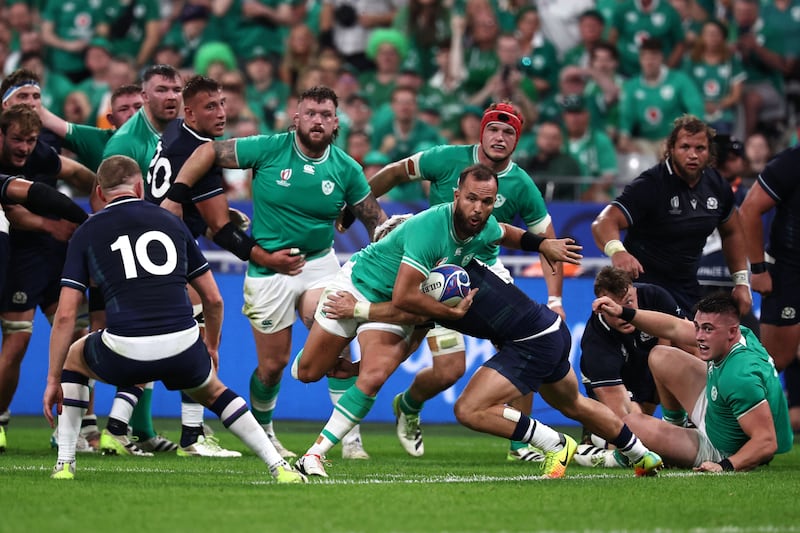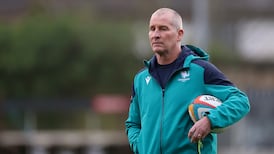Plus ça change, plus c’est la même chose is an expression tinged with resignation coined by French novelist, journalist and critic Jean-Baptiste Alphonse Karr, way back when. But the Ireland team offered a new, more positive twist on the sentiment during a stunning first 50 minutes in their Rugby World Cup pool victory over Scotland at the Stade de France.
Andy Farrell has challenged the squad to be adaptable, to embrace the wrinkles of professional sport and not be cowed by challenges, mental or physical, a philosophy to which the players have enthusiastically subscribed. It’s embedded in the DNA of the team’s success.
Emboldened by the perfect start, James Lowe’s try, the fastest ever in Irish history at the World Cup, Ireland were gone in a smidgen over 60 seconds, the prognosis for Scotland going from defiant to dreich.
Gregor Townend’s side doubled down on chasing tries and by the time the game paused to draw breath on 10-minutes, they’d lost fullback Blair Kinghorn and saw their high-risk investment yield precisely nada on the scoreboard.
READ MORE
Ireland’s pre-eminence in the first half didn’t come without issues, initially losing Mack Hansen to a Head Injury Assessment (HIA) and then a calf injury. At half-time, Ireland had to focus on James Lowe’s eye problem that forced him out of the game.
Farrell turned to two of his team’s outstanding players in the first half, scrumhalf Jamison Gibson-Park and centre Garry Ringrose, to fulfil new remits as wingers. Everything had changed yet it remained the same, two players operating out of position but no compromise in terms of the quality of their input as individuals or in the smooth functioning of the team.
[ Rugby World Cup: Five things we learned from Ireland’s win over ScotlandOpens in new window ]
It’s a tremendous boon to the collective confidence in fulfilling the expectations of the coaching group that players remain nonplussed when faced by adversity. Ringrose had enjoyed a stunning first half in an attacking creative capacity in his natural role as a centre.
It was his show-and-go that bamboozled Grant Gilchrist in midfield and as he accelerated through the gap his perfectly timed offload allowed Hansen to send Lowe over for the try. When the Connacht wing was injured in trying to score a try, Stuart McCloskey came in at inside centre, Bundee Aki moved out one place and Ringrose was restationed on the wing.
The players had to live the maxim about being adaptable through the disparate challenges. McCloskey did (two turnovers, a headline statistic), Aki did, and Ringrose did emphatically, displaying some neat soccer skills, a throwback to his days with Granada, and then working off the blindside wing back into familiar midfield terrain for a definitive intervention in Hugo Keenan’s first try.
Ringrose held his width intelligently for his try, relying on replacement outhalf Jack Crowley to spot his teammate’s splendid isolation and deliver a pinpoint cross-kick; the former Bandon boy delivered on the double.

Jamison Gibson-Park, as is his wont, had injected tempo into Ireland’s game in the opening 40-minutes, whip-smart in his game management, and in more mundane chores like box-kicking and patrolling the Irish backfield.
He invariably chose the right carrier for the next task, something that is occasionally underappreciated yet integral to high performing attacking values. Gibson-Park’s immediate post interval role was to relocate to the wing following as Lowe’s compromised vision was no longer sustainable.
Akin to Ringrose, the scrumhalf, adapted in a conspicuous way quickly, 43-minutes to be precise. As the ball came to him on the right touchline, he stepped inside the tackle of Duhan van der Merwe, meandered infield and then when Ireland won the ensuing ruck ball, he hustled impressively to contribute again immediately to Ireland’s attacking shape.
At first lurking out of the back of the front-line alignment, he took possession and responsibility to hit hooker Dan Sheehan with a long pass, thereby giving him the time and space to cross for a try in the corner.
There were many other highlights to Gibson-Park’s man-of-the-match performance but one that epitomised a brilliant attitude and application came near the start of the final quarter when he won a penalty turnover.
It represented a high value moment at a time when Scotland finally managed to get some purchase with a couple of tries against a tiring Irish side carrying a couple of passengers because of bumps.
[ Bluffer’s Guide: How to talk the talk after Ireland’s 36-14 win over ScotlandOpens in new window ]
If those represented the arrowhead of the Irish performance then there were others like Iain Henderson, charged with re-establishing the equilibrium of the Irish lineout, in tandem with the returning Sheehan. Two players stepping in and stepping up.
A word too on the contribution of replacement hooker Ronan Kelleher. He, along with the Irish lineout as a unit, had endured a tough time against the Springboks. It’s not necessarily a case of him paying a price in terms of losing his place in the starting team but there would have been plenty of eyeballs on his arrival just shy of 50-minutes to see how he responded.
The short answer is impressively, arguably Ireland’s best player on both sides of the ball in that final half an hour, in a team that had lost some cohesion was hobbled by walking wounded.
Farrell has consistently said that Ireland can’t be spooked by circumstance and that it is important to focus on the solution rather than the problem. His team did that on Saturday night at the Stade de France.
Plus ça change in terms of injuries and the required reshuffle in personnel but crucially plus c’est la même chose, when reflecting on the performance. And so it must continue for a little while longer.
















